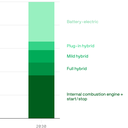Consumers are open to electric vehicles, but face a steep learning curve

Americans are more open than ever to trading in their gas cars for electrified vehicles — but they're flummoxed by the confusing array of green options arriving in showrooms.
Why it matters: Getting up to speed on the differences among hybrids, plug-in hybrids and battery-electric vehicles will be a challenge for car buyers — and salespeople, too — as we transition away from gas-powered vehicles over the next decade.
What's happening: Overall car sales are down, but sales of electrified vehicles — hybrid, plug-in hybrids and electric vehicles (EVs) — nearly doubled in the third quarter, to 10.4% of total sales from 5.5%, according to Kelley Blue Book.
- Pure EVs, which have no combustion engine, were still just 3% of the total, partly because of their price tag: nearly $60,000 on average, before rebates, says KBB parent, Cox Automotive.
- Until EV prices come down, hybrids and plug-in hybrids are a more affordable option for many car buyers.
Yes but: While consumers are more aware of these alternatives, they don't fully understand them, says Toyota, which introduced the Prius 25 years ago and dominates the U.S. market for hybrids.
- 75% of consumers surveyed by Toyota believe hybrids need to be plugged in, for example. That's not true.
- Two-thirds of consumers surveyed think a battery-electric vehicle has an engine — also not true.
- "After 25 years, consumers are still very confused," said Mike Tripp, VP of vehicle marketing and communications at Toyota North America.
Here's a quick primer on some terms buyers are likely to encounter:
- Start-stop technology — this common fuel-saving system automatically shuts down and restarts a gasoline engine when the vehicle stops.
- Mild hybrid — sometimes called e-assist, it's a gas-fueled car with an electric motor for added oomph during acceleration. The electric motor can't power the car on its own, but it can boost fuel economy as much as 20%.
- Full hybrid — Toyota's Prius is a good example: The car has both a battery-powered electric motor and a gasoline engine, which operate independently or together. The e-motor can add power to supplement the engine, lowering fuel consumption.
- Plug-in hybrid — With a larger battery and a more powerful motor, a plug-in hybrid can go 10-50 miles on electricity. That means you don't need to buy gas for short trips around town. When the battery is depleted, it operates as a regular full hybrid.
- Battery-electric vehicle — The car must be plugged into the electric grid to recharge the battery, or it won't run. Most cars take 8-12 hours to recharge fully, although faster options are available. Today's BEVs usually get at least 250 miles between charges.
What's next: The number of electrified models is projected to explode over the next five years.
- In 2020, there were 24 battery-electric models for sale in the U.S.; by 2025, IHS Markit projects that number will be 146.
- Add various types of hybrids to the mix, and there will be 220 new or redesigned electrified models introduced between 2022 and 2025.
The bottom line: The EV era is going to take time to mature.
Get smarter, faster on climate technology with our free, 5-video short course.
Editor's Note: Cox Enterprises, the parent of Kelley Blue Book and Cox Automotive, is an investor in Axios.